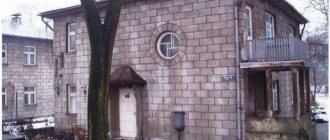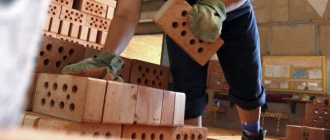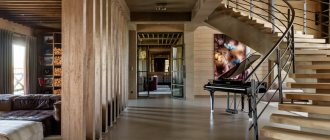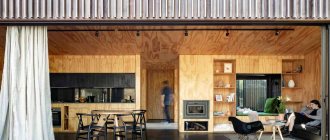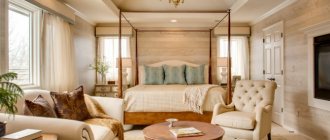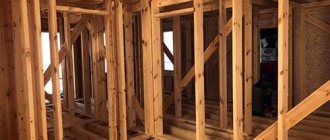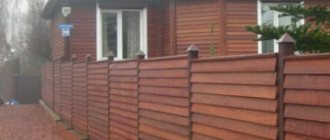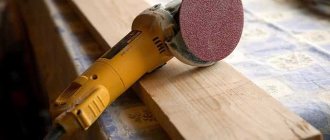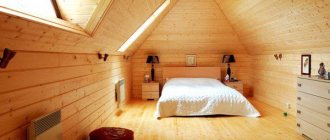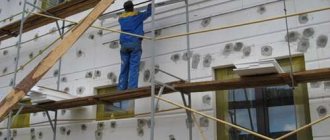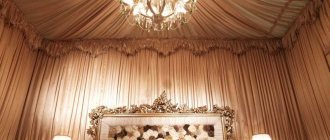Peculiarities
A house made of timber has a number of characteristics that are not typical for houses made of other materials. Among them there are both positive and negative qualities.
The advantages of wood include:
- The material is environmentally friendly.
- A house built from timber has a very presentable appearance.
- Constructing a building from wood elements takes less time than working with other materials.
- There is no need to spend a lot of time laying an expensive foundation, since the timber will not create large loads.
- Compared to other materials, wood has a lower price.
The following points are considered as nuances that cause difficulties:
- Over time, shrinkage of wooden buildings usually occurs. In its primary stage, it occurs during the first two years from the moment the house is built. Under the weight of the roof, the distance between adjacent beams decreases, resulting in the formation of cracks, as well as a decrease in the ceiling height by a couple of centimeters.
Also, the shrinkage process can be explained by changes in temperature and humidity, but in this case the interior finish most often remains unharmed.
- Wood is also a material that can develop infestations or rot over time. Therefore, you need to carefully process the beams and monitor the humidity level.
When the building is erected, all the internal work to be performed must be carefully planned.
The main procedures for interior arrangement and finishing include:
- Laying communication systems. These include heating, sewerage, electricity, and water supply systems.
- Coating walls with special compounds and antiseptics that protect against fire.
- If desired, you can carry out thermal insulation and waterproofing of the floor and walls.
- Next, the subfloor is laid.
To make the work more organized, it is recommended to prepare in advance a project for the arrangement and finishing of all rooms.
- Partitions and other additional structures are being installed.
- Walls, ceilings and floors must be carefully prepared before decorative finishing.
- After this, the finishing itself is carried out.
The interior decoration of a building made of timber as a whole is a rather labor-intensive process, so it is important to describe in detail all stages of the work, as well as to correctly select the material for finishing various surfaces.
Finishing ceilings in a wooden house
The next stage of finishing work is working with the ceiling. Many designers advise not to change the concept of the ceiling and leave it in its natural form, then the finishing materials can be lining, boards, plywood sheets, or special slats.
softwood ceiling trim
Among lovers of wooden buildings, many want to see more modern materials in the house and with their help create real masterpieces of the interior. Coatings made from the following materials come first:
- Drywall.
- Plastic panels.
- Stretch ceiling.
Plastic panels
ceiling decoration with plastic wood panels
The most cost-effective option is a ceiling made of plastic panels. A wide selection of colors and textures will help you create the most picturesque ceiling that will meet any fantasies. Installation of panels is carried out as in the case of walls.
Stretch ceiling
a mirrored stretch ceiling will be a highlight in any interior
Recently, stretch ceilings have become increasingly popular. This is the most interesting and beautiful type of coating, capable of radically changing the perception of space. An endless number of color options expands design possibilities. A special feature of suspended ceilings is their high resistance to moisture, ease of maintenance, and a perfectly flat surface. It is worth noting the following advantages of this coating:
- Simplicity and speed of installation work.
- No debris during installation.
- Possibility of installing built-in lighting.
- Increased strength of the ceiling covering.
- Stretch ceilings do not absorb foreign odors.
- Behind the ceiling it is possible to hide all defects.
- Ceilings do not require special care and are not demanding on maintenance.
Using drywall
perfectly flat plasterboard ceiling with hidden lighting
The most widely used material is plasterboard. This versatile material can change the interior not only through the walls, but also as a ceiling covering. Among the advantages of drywall, it is worth noting the following:
- Environmentally friendly material, safe for humans.
- As a result of using the material, a perfectly flat surface is obtained.
Ceiling plasterboard, as in the case of walls, is mounted on a frame made of a metal profile. In this case, the cladding is not affected by the deformations that wood is subject to over time, and the ceiling has a long service life.
Front of work inside a timber house
Finishing the floor, walls and ceiling in a log house made of laminated or profiled timber is done by hand in several stages:
- laying communication lines (electrical cable, pipeline, heating system, sewerage, air conditioning);
- impregnation of wood with antiseptic agents to protect against fire, insects, mold and fungi;
- installation of heat and waterproofing material;
- preparing walls, floors and ceilings for finishing;
- installation of interior doors;
- finishing of floors, walls and ceilings.
Without certain skills and the necessary knowledge for renovating premises, it is better to seek help from professionals, especially when it comes to communications. If you are confident in your abilities and do not want to overpay, you can safely do the work yourself. It is advisable to decide on the design and think through every detail of the interior before starting.
This measure will help you have an idea of the future result and calculate the required amount of material intended for these purposes.
Selection of materials
In the process of repair and construction work inside the house, craftsmen use a variety of finishing materials.
The most popular and common options include:
- · Linings made of plastic or wood;
- · Panel siding;
- · Coatings made of decorative stones;
- · Block house and drywall.
A successful solution when decorating the interior space of a house would be to combine these materials. Today, thanks to modern technologies and capabilities, there are a great many options; the final result will depend only on your imagination.
Floor construction
Finishing floors in timber houses begins with the development of the subfloor. In other words, the surface is first treated with a protective impregnation, then insulation is applied to it and a backing is attached, and then the final clean coating is laid down.
Experienced specialists inside log houses prefer to use universal spruce or pine tongue and groove boards for laying floors.
This is exactly the material that will serve you for at least 20-30 years, will not darken or change for a long time, is not afraid of scratches and is easy to care for.
The darkened color of these wooden coverings can be easily restored, along with all the external beauty and uniqueness of the original palette of shades, by simply sanding the surface and then covering it with a protective composition.
Finishing the floors inside the house in such a situation excludes only the installation of a “warm floor”. Since this system, on the one hand, carries the threat of a fire, and on the other hand, all these processes are impractical, since they are very energy-intensive and costly.
Wall decoration
Wall decoration in houses made of timber also has a number of its own characteristics, where the main guideline is the material that you intend to use.
Natural wood
If you decide to decorate the walls of your building with logs, then it is possible to keep the walls unfinished. This is true if the wood from which the walls in the house are built does not have any flaws or other features.
In this case, you only need to treat the material with a composition to protect it, give it the color you want, and also to extend its service life.
Dye
If you have chosen to paint the walls as an interior decoration, then this solution will help you add uniqueness and originality to the interior design of your home, and will also provide an additional level of protection to the material and preserve its natural structure.
It is only important to choose for these purposes paint and varnish materials that contain a minimum amount of harmful and chemical substances.
Plaster
Treating the building and internal walls with plaster is a process that can only be performed if more than 1-2 years have passed since the construction of the house. When finishing walls with plaster, it is important to pay due attention to the process of waterproofing the original material from which the entire surface of the walls of the house is made.
Block house and lining
It is possible to start decorating the walls of the house using these materials if the shrinkage of the house is completely completed. For these procedures inside the house, it is imperative to create special frames in the rooms, which quite significantly reduce the total space in the room.
It is worth noting that both of these finishing materials preserve the original patterns of wooden walls and give them a more neat and tidy appearance.
Panels
By choosing panel wall decoration inside a house made of timber, you provide yourself and your family with completely environmentally friendly and hypoallergenic material.
The advantages of panel wall finishing include: ease of processing, complete and easy exposure of the material to installation work, high thermal insulation, complete noise absorption.
Such decoration on the walls can later be easily covered, for example, with wallpaper or fabric.
Drywall
This type of finishing of the walls of a house made of timber can be characterized as almost universal, since after applying putty to it, you can glue wallpaper, lay tiles, leave plaster, and also paint the walls.
It is important to know that the plasterboard sheets themselves are green in color; for rooms with high humidity, you should buy plasterboard that is well resistant to moisture. This is a completely environmentally friendly material; it is installed on a metal or wood base.
Also, this type of finishing protects the sheathing and surrounding walls from cracks and damage on their surface, and it is convenient to place an insulating layer on it. Drywall is also easily affected if wiring, plumbing or other types of communications are laid under it.
Ceiling finishing
Processing the ceiling in houses made of timber is an optional work that depends on the owners themselves and their preferences and has its own characteristics. An unlined ceiling fits into any style and interior design, into any ideological composition for home decoration.
If another 5-7 years have not passed since the construction of the house and the beginning of its shrinkage, then a beautiful stretch ceiling or plasterboard can be an excellent solution for finishing the ceiling.
These materials will close the ceiling hole, and will not deform at all or interfere with the natural process of shrinkage of the entire house. Once the reassignment of stress in the ceiling supports due to this process is completed, its finishing can be carried out using conventional methods (plaster, etc.).
Construction technology
The seams in timber walls are straight and horizontal, unlike in log buildings. There are 2 main ways in which timber is laid out:
- “in the area” – the remainder of the material remains at the edges;
- “in the paw” - without a trace.
Thermal insulation material is laid in the seams . They can be tow, felt or mineral wool. Afterwards, the outer walls are caulked and covered with paint or other finishing material. Internal and external walls are erected simultaneously.
Cladding is carried out only after complete shrinkage of the walls.
Brief instructions for assembling a wall from timber:
- Rolled waterproofing is laid between the first row of the wall and the plinth. A board is placed on top of it and soaked in mastic. A layer of tow is placed on top of it, followed by another layer of waterproofing to prevent possible rotting of the timber due to moisture in the base.
- The bars are laid with bandaging in the corners. Elements of the internal and external walls can have different lengths. The corners of the first row (crown) are connected using the “half-tree” method.
- The corners of the remaining rows are connected by ligating with a root tenon. A groove is made for it, the element is driven tightly inside, secured with a dowel (made of metal or wood) with the current and subsequent crowns.
- The connection between the internal walls and the main walls is made using tenons and dowels. Installation is carried out in a groove created using an electric saw.
- Window and door openings are also created using a saw.
Assembly by connecting to the main tenon is considered one of the most difficult, but it creates a windproof corner. The joints turn out warm and smooth, however, everything has to be cut out by hand, so the process is long and expensive. Pays off in savings on heating costs.
You will find more information about the construction of timber walls here.
Installation of windows and doors
At the stage of installing doors and windows in houses made of timber, you should carefully consider the entire process and strictly follow the recommendations. Since this process in buildings of this format differs from similar installations in buildings of other materials.
All this is again connected with the natural process of shrinkage of the material, which must be taken into account during design work and during the construction process.
Window installation
Installing a window in a house made of timber will also have many features and nuances. For example, when installing a small window, the height of which does not exceed 3-4 logs, the shrinkage of the house can be ignored.
If the height of the window ranges from 8 to 10 logs, then for installation you will need to use a special casing frame. Also, the method of manufacturing a window frame will depend on the material used for the windows that will be installed in the house (plastic, wood).
Door installation
The installation of doors and door openings in houses made of timber occurs in a similar way to installations in buildings made from other materials; in addition, casing frames should be used in the process.
The final process of installing doors and windows in a timber house should be carried out after complete completion of construction work. The choice of windows and doors themselves is at the discretion of the owner of the house.
What types of finishes are there?
Depending on the purpose of interior decoration, various technologies and materials can be used. The following main types of such events can be distinguished:
Coatings that preserve the appearance of the timber are designed to protect wood from moisture and other external influences.
In this direction, methods such as varnishing and impregnation of wood with special compounds, incl. providing wood tinting, i.e. enhancing its textured appeal.
The interior decoration of the house with imitation timber (photo 4) completely covers the surface of the log house, but forms a new surface that imitates wood in appearance. The main methods of imitation: the use of lining, block houses and wood siding.
Such coatings are good for covering old timber or creating the desired interior. In addition, with their help, additional thermal insulation of the house is provided.
Coatings that completely change the appearance of a wooden surface are used when it is necessary to mask a defective wooden surface or the need for additional thermal insulation. The main methods: plastering, painting (photo 5), finishing with plasterboard, artificial stone.
These technologies completely hide the timber, and the interior does not use a style associated with wooden elements.
An important advantage is the formation of a perfectly flat surface and the ability to decorate in any style. In addition, dense coatings make it possible to provide distribution of various communications and lighting, and enhance thermal insulation.
Specificity of wooden buildings
In general, the interior decoration of a residential building means a number of measures to create the interior, external covering of the floor, walls, ceiling, arrangement of door and window openings, and organization of communication systems.
An example of interior decoration of a wooden house
Houses made from wooden beams have a number of characteristic features related to the properties of wood. The main features include the following factors: significant shrinkage within 4-7 years after completion of construction work and high sensitivity to moisture, which causes a change in all properties of the material and destroys the wood.
These factors largely depend on the type of timber used. When building a house, as a rule, profiled or laminated timber is used. Profiled products can have different degrees of drying, which determines the degree of shrinkage. The height changes both as it dries and due to the compaction of the gap between the layers. As a result, shrinkage can reach 2.5-4 cm.
Glued laminated timber for house construction
Glued laminated timber is much more expensive than its profiled counterpart, but its shrinkage is minimal. As for the problem of moisture resistance, this is a property of the wood itself, and to increase resistance, external protection against moisture penetration is necessary.
Profiled timber for house construction
What other nuances should be noted? First of all, the purpose of the decoration is essential: furnishing a new home or renovating a room that has existed for many years. In the first case, it must be taken into account that wood is usually used in construction because of its attractive appearance: special texture, naturalness, environmental friendliness, originality.
Interior decoration of a timber house
Taking into account these important properties, it should be noted that veneering new timber will remove all the attractiveness of the timber. For a new house, it is more typical to finish it while preserving the external attractiveness of the wood, but ensuring its protection from moisture and taking into account shrinkage phenomena.
Interior decoration of a house made of profiled timber
After using the house for a long time, the timber may lose its attractiveness, become deformed and damaged.
When renovating an old room, it is more rational to use coatings that completely cover the damaged surface and create a completely new interior.
Interior decoration of a house made of round logs in a modern style
The choice of type of interior finishing largely depends on the type and quality of the building timber. Thus, the interior decoration of a house made of laminated veneer lumber (photo 3) should take into account the high quality of the product used. Such timber has an almost perfectly flat surface, emphasized texture, fairly high resistance to moisture, and its shrinkage is insignificant and is completely completed after 10-12 months. Such timber should not be covered with dense coatings, but, on the contrary, it is necessary to emphasize the texture.
Updating the interior of a timber house
It’s another matter when regular or profiled timber is used without special drying. In addition, in order to save money, products are often used that have various surface defects and slight deformation, which leads to the formation of uneven gaps. Under these conditions, interior finishing is required that can hide defects.
The natural beauty of the timber is emphasized
Application of various compositions
For the interior decoration of a wooden house, several types of compositions are used: varnishes, paints, mastics, oils. They can be transparent, tinting and impregnating, but all have the main purpose - protecting wood from moisture and rotting.
For interior work, glossy, matte and semi-gloss varnish compositions are used. The most commonly used materials are water-based, which eliminates strong odors, although it somewhat lengthens the drying time. If quick drying is necessary, you can use nitro varnishes, which require careful ventilation after completion of work.
The glossy variety is intended for hallways, living rooms, and common areas. The matte option is more suitable for bedrooms, especially children's bedrooms.
Paints are used to create an opaque coating and are often combined with the application of plaster. The main advantage is the ability to provide any color scheme in accordance with the chosen interior. Acrylic paints and enamels are widely used.
Wax mastic can be transparent or in various shades to emphasize the wood texture. It reliably protects the timber from moisture and preserves the natural pattern of the structure for a long time.
This material has an increased cost, but it does not form a surface film, which provides a breathing effect for the wood.
Impregnation with an oil composition protects the wood from rotting and provides a golden hue while maintaining the texture. Natural oils are used: linseed oil or so-called Danish oil obtained by cold pressing.
How to imitate wood
In some cases, it is necessary to completely cover a wall of timber and create a space between the wall and the covering (manufacturing thermal insulation, laying communications, ventilation, etc.), while you want to preserve the appearance of the tree. For this purpose, various technologies for simulating a log house are used.
One of the most common options is clapboard cladding (photo 4). At its core, lining is wooden slats of different widths and lengths. Before installing them, a lathing and wooden beams are installed on the wall, in the cells of which heat and vapor barrier and waterproofing are placed. Communications and electrical wiring are being installed.
The lining strips are fastened on top of the sheathing with screws. The planks can be placed both horizontally and vertically. After completion of the work, the coating is impregnated and varnished.
Insulation
Used to protect your home from cold winds:
- Hanging materials: mineral wool, polystyrene foam, polystyrene foam . For installation on the wall, a frame is created, the insulation is attached in layers to brackets or plate-shaped dowels. The wall is covered with finishing materials.
- Polyurethane foam spraying . Installation is carried out using special equipment. The material adheres well to the surface and is environmentally friendly.
Features of insulating walls made of timber:
- work begins after the house has completely settled;
- before starting insulation, it is necessary to repair all cracks, strengthen the seams, and treat the surface against fungus;
- The thermal insulation material must be combined with the wood from which the timber is made.
A correctly carried out insulation procedure allows you to save a decent amount on heating the house during further operation.
The process of insulating timber walls is shown in the video:
More information about insulating walls made of timber is described in our material.
Fundamental differences between finishing a house made of timber and stone
To be confident in the success of using this or that type of coating, you need to understand how the mechanics of behavior of a wooden house differ from brick and frame ones. Wood is an extremely unstable material; it tends to expand and contract with changes in humidity and temperature. Therefore, the finishing system must normally perceive mechanical vibrations of the base.
Another feature of a timber frame is its ability to allow water vapor and cold air to pass through.
The presence of any coating does not fully smooth out these shortcomings, so the log house must be well caulked, and ideally, sealed with liquid seams. To prevent the formation of condensation under the curtain wall, a blind vapor barrier with a two-sided air gap should be used.
The third and most important nuance is that finishing cannot be carried out immediately after assembling the log house. Depending on the number of floors, type and quality of materials, time is required for shrinkage and residual deformation. For glued laminated timber this period is up to six months, for solid timber it is about 10–15 months, and a house made of rounded logs can take several years to shrink.
It must be remembered that after the first and second caulking, the log house should also settle almost to its original size.
Electrical and communications
There are no difficulties with horizontal laying of heating and water supply pipes in a wooden house. They are placed as close to the floor as possible, if desired, hidden under a false box trimmed with wood-like panels.
It is only important to correctly arrange the passages through the walls; as a rule, for this, cells are cut out during the assembly of the log house, then the cavities are filled with soundproofing material.
The situation with wiring is much more complicated. The low current is easily hidden in the channel plinth, but power networks are not allowed to be hidden inside flammable materials. One option is to lay the wiring openly, using wires without overall insulation, twisted into a braid and stretched over ceramic plugs. This solution is quite interesting from an aesthetic point of view and at the same time completely safe.
Hidden wiring in a log house is also possible, but its planning is carried out at the stage of assembling the house. In each beam it is necessary to drill coaxial vertical channels into which, after laying the final crown, steel pipes will be inserted, inside which the cable will be passed.
The main wiring is carried out inside the ceilings, and the cable must be encased in a non-flammable hard shell.
Do not be deceived by the experience of foreign builders who lay cables inside frame and wooden walls without any additional protection. Abroad, different mains voltage parameters apply; special types of cable are used that are not available for the domestic market; in addition, the distribution board must be equipped with fire protection devices.
Features of cladding wooden walls in wet rooms
When decorating rooms in a wooden house where a microclimate with high humidity is expected, you need to use only materials for wall cladding that can withstand its effects. On those surfaces that will not be in direct contact with water, you can use moisture-resistant plasterboard or Quick Dec boards as finishing. Those walls where water will get in often and in large volumes are best hidden behind plastic, decorative stone slabs or ceramic tiles.
Moisture-resistant Quick Dec boards
It is important to seal the sheathing so that the wooden walls hidden behind it do not rot or bloom due to water leaks. It wouldn’t hurt to pre-treat their surface with moisture-proofing compounds. When decorating walls, special attention is paid to areas located behind the bathtub, toilet, and adjacent sinks.
Tips and tricks
To ensure that the process of finishing the interior of a wooden house goes without complications, it is better to listen to the recommendations of specialists:
- When laying wood floors, wedge technology can be used to achieve the best joint between the floorboards.
- To prevent condensation from forming on a wooden surface during a suspended ceiling, a waterproofing layer of a polymer membrane should be built into the suspended ceiling.
- Please note that home furniture made from timber should be made from natural raw materials, otherwise the design concept may be violated.
- You can use special sealants between the joints of the logs. Such sealing agents have a special structure and can even act not only as a functional, but also a decorative element.
If you do not have much experience in finishing work, then invite specialists to finish a wooden house, since some work really requires professional skills.
Basic requirements for facing material
Walls in a wooden house should be clad taking into account the shrinkage of the structure.
Walls in a wooden house should be clad taking into account the shrinkage of the structure. The shrinkage process directly affects the selected material. Before cladding a building, pay attention to the following points:
- Seasonality of residence. The house is not always used for permanent residence. When covering with inexpensive materials, there is a possibility of their deformation or cracking, because... in winter, the temperature inside the house will not be comfortable.
- Design parameters. The weight of supporting structures is of great importance, because... when they shrink, they can significantly deform the decorative coating.
- Environmental standards of the material. Not all products meet environmental standards; even the most expensive product can release toxins or formaldehyde compounds.
- Cost and appearance. Cheap doesn't mean bad. Expensive material is not always able to be of high quality and fit harmoniously into the overall interior.
When choosing a material, consult with experts and study reviews, then you can clearly answer the question of how to cover the walls in a wooden house.
Beautiful examples
There are many ready-made solutions on how best to decorate the rooms of a wooden house. The most successful and interesting are the following options:
- Decorative stone is often present on individual elements of a wooden house, focusing attention on their importance in a particular room. Such coatings are often used on walls near the fireplace or dining areas.
- The floor surface can be made of artificially aged boards. This detail will successfully complement some interior styles.
- Wicker furniture looks unusual in the interior of a timber house. It looks original, but does not overload the decor.
- Often in houses made of timber, wooden beams are used to decorate the ceilings.
- Using all the recommendations and nuances outlined above, you can create the perfect interior in every room of a wooden house.
Finishing the floor in a wooden house
Finishing the floor in a wooden house
To finish the floor in a wooden house, you can use ceramic tiles, laminate, parquet or linoleum. Artificial stone also looks good here. It can also be combined with the same type of finishing for the foundation of a wooden house. But please note that it must be placed correctly. Therefore, take into account all the nuances of construction.
